
Elite female athletes at greater risk of eating disorders
Especially in disciplines like running and gymnastics, where body weight is especially associated with aesthetics and fast running times.
An extremely slender and well-trained body, strict diet, low body fat, and a BMI of 18.5. But still worried about your body shape.
Are these the traits of a person with an eating disorder? A top athlete? Or perhaps both?
In many sports where body weight is associated with performance or aesthetics, the pursuit of low body weight may overshadow other, more important, parameters for optimal performance, such as sufficient carbohydrate intake.
In fact, a wealth of research now shows that more than 40 per cent of women engaged in aesthetic sports to a professional level, like dance and gymnastics, show signs of an eating disorder.
And similar figures apply to endurance sports like running, where you move your own body weight over a longer period of time and low body weight is often an advantage.
Read More: Test yourself: Are you addicted to exercise?
When do you have an eating disorder?
An eating disorder is a mental illness. It is typically characterised by a high level of body dissatisfaction and an attempt to regulate body mass by restrictive eating, overtraining, or vomiting.
It is often accompanied by a loss of control of eating habits, leading to overeating and a variable body weight.
Women develop eating disorders more often than men, though the prevalence of male eating disorders seems to be rising.
In Denmark, approximately one per cent of young girls suffer from anorexia, while bulimia is up to five per cent.
A lesser-known condition is disordered eating, which is not classed as a disease but may be a precursor to developing an actual eating disorder.
It is typically described as an unhealthy diet, where people worry about calories and their body, they train obsessively, and perhaps show initial signs of a malnourished body. We don’t know the exact number of people in this grey area.
Read More: Women athletes suffer more knee injuries
Aesthetic and endurance athletes are most at risk of eating disorders
Sports such as cycling, dance, and high jump, often perceive a slender body and a very low fat percentage as crucial for optimal performance.
Here, the expectation of a defined, trim body may lead to an exaggerated preoccupation with body shape, diet, and weight loss: the precursors to disordered eating and extreme weight loss.
This is especially worrying, given that sports men and women in general often have a higher self esteem than the general population. But while most athletes prioritise performance and strength over looks, other athletes can easily be pushed in the wrong direction.
Research shows that eating disorders often occur in sports where body weight has an aesthetic significance (such as gymnastics), in weight-bearing activities (such as running) and weight class sports (martial arts), where you fight against others within the same body weight category.
Forty-two per cent of elite female athletes in aesthetic sports and twenty-four per cent of female endurance athletes show symptoms of having an eating disorder, according to a 2004 Norwegian study.
Elsewhere, 21 to 45 per cent of high-level competitive swimmers are reported to have disordered eating, and seven per cent had an actual eating disorder.
A 2000 meta-analysis summarised 34 studies of eating disorders in young female pro-athletes, and showed that elite athletes have an increased risk of eating disorders compared to both non-elite athletes and non-athletes, and again that this was particularly prevalent in sports where body weight is crucial to the performance.
And it affects young athletes too. A 2013 study of first year high school athletes reported an increased incidence of eating disorders (7 percent) compared to a control group (2.3 percent), and a higher prevalence among girls than boys.
Read More: Elite sport: time to scrap the therapeutic exemption system of banned medicines
Female athletes are more at risk than men
These trends have been replicated by a number of other studies from around the world. And reveal that professional female athletes are more susceptible to eating disorders than their male colleagues.
In the U.S., female runners have reported a higher level of body dissatisfaction and symptoms of eating disorders than male runners, according to a 2016 study of 400 runners. A high degree of body dissatisfaction was linked to an increased risk of eating disorders.
A study from the Netherlands also found a clear link between a negative body perception and eating disorders among top female athletes.
Women with eating disorder symptoms reported feeling larger than their female colleagues who did not suffer from an eating disorder, even though there were no real differences in either body weight or shape between the two groups.
Read More: Training can treat eating disorders
Pro-athletes more at risk than amateur athletes
An Australian study from 2002 investigated 263 elite athletes and compared them to 263 non-athletes matched on gender and age. They showed that the top athletes experienced a pressure to be slim and reported more eating disorder symptoms compared to non-athletes.
Again, this was especially true for women, where 15 per cent of elite female athletes met the criteria for anorexia and bulimia, while another 16 per cent showed signs of having an eating disorder
Among the non-athletes the numbers were far lower. Only one percent of non-athletes met the criteria for anorexia or bulimia, and five percent showed signs of having an eating disorder.
None of the male non-athletes suffered from eating disorders, compared to six percent of professional male athletes.
Read More: Thin evidence behind “revolutionary” blood sugar diet: Scientists
Body dissatisfaction driven by surroundings
So what is going on? And how can we explain some of these trends?
We know that athletes often compare their own bodies to that of their competitor, and that this might be one of the triggering factors for body dissatisfaction. And research shows that female athletes judge their bodies more harshly when they compare themselves to their competitors rather than the general population.
Thus body perception is not stable, but depends on our surroundings.
For example, an at risk athlete with 15 per cent body fat surrounded by competitors with a fat percentage of 10, could slip into bad eating habits and body dissatisfaction, even though 15 per cent body fat is relatively low, especially for women.
At the same time, low self-esteem, high body ideals, performance anxiety, and pressure of meeting expectations of trainers and friends, are all clearly linked to restrictive and disordered eating.
But despite the wealth of research to document the phenomena of eating disorders among elite athletes, we still lack initiatives to prevent and reduce the problem.
One exception is Norway, where athletes representing the country now have to have health certificates. If the athlete is deemed to be in a nutrition deficit condition or to have an eating disorder, they are not granted the certificate and restrictions are placed on their training.
Whether the Norwegian approach is the right one to drive down down incidences of eating disorders, especially among female professional athletes, requires further research.
---------------
This article is co-published with The Conversation, and in Danish at Forskerzonen, part of Videnskab.dk.
Scientific links
- "Risk factors for disordered eating in female university athletes", Journal of Sport Behavior (2000)
- "Prevalence of eating disorders in elite athletes is higher than in the general population", Clinical Journal of Sports and Medicine (2004) DOI: 10.1097/00042752
- "Disordered eating and eating disorders in aquatic sports", International Journal of Sport Nutrition and Exercise Metabolism (2014) DOI: 10.1123/ijsnem










